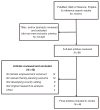WOMEN'S EMPOWERMENT AND FAMILY PLANNING: A REVIEW OF THE LITERATURE
- PMID: 28069078
- PMCID: PMC5503800
- DOI: 10.1017/S0021932016000663
WOMEN'S EMPOWERMENT AND FAMILY PLANNING: A REVIEW OF THE LITERATURE
Abstract
This paper reviews the literature examining the relationship between women's empowerment and contraceptive use, unmet need for contraception and related family planning topics in developing countries. Searches were conducted using PubMed, Popline and Web of Science search engines in May 2013 to examine literature published between January 1990 and December 2012. Among the 46 articles included in the review, the majority were conducted in South Asia (n=24). Household decision-making (n=21) and mobility (n=17) were the most commonly examined domains of women's empowerment. Findings show that the relationship between empowerment and family planning is complex, with mixed positive and null associations. Consistently positive associations between empowerment and family planning outcomes were found for most family planning outcomes but those investigations represented fewer than two-fifths of the analyses. Current use of contraception was the most commonly studied family planning outcome, examined in more than half the analyses, but reviewed articles showed inconsistent findings. This review provides the first critical synthesis of the literature and assesses existing evidence between women's empowerment and family planning use.
Figures



References
-
- Abadian S. Women’s autonomy and its impact on fertility. World Development. 1996;24(12):1793–1809.
-
- Al Riyami A, Afifi M, Mabry RM. Women’s autonomy, education and employment in Oman and their influence on contraceptive use. Reproductive Health Matters. 2004;12(23):144–154. - PubMed
-
- Amin R, Hill RB, Li Y. Poor women’s participation in credit-based self-employment: the impact on their empowerment, fertility, contraceptive use, and fertility desire in rural Bangladesh. Pakistan Development Review. 1995;34:93–120.
-
- Amin R, Li YP, Ahmed AU. Women’s credit programs and family planning in rural Bangladesh. International Family Planning Perspectives. 1996;22(4):158–162.
Publication types
MeSH terms
Grants and funding
LinkOut - more resources
Full Text Sources
Other Literature Sources
Medical

